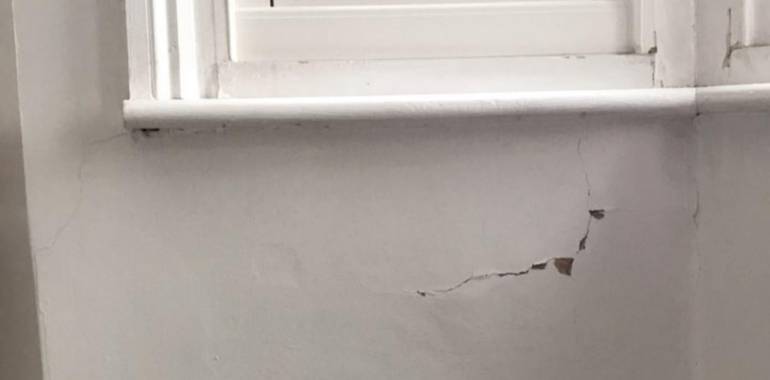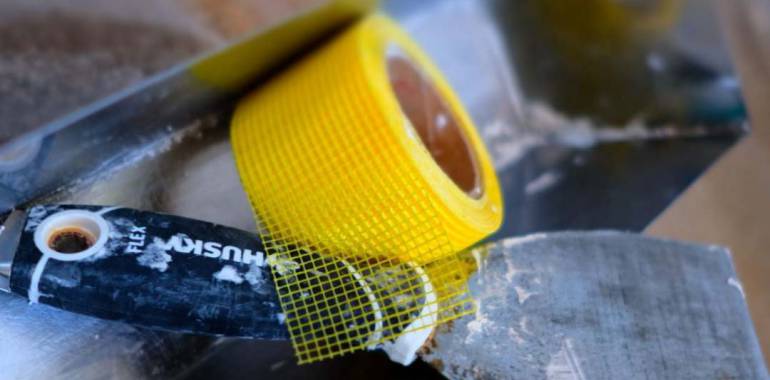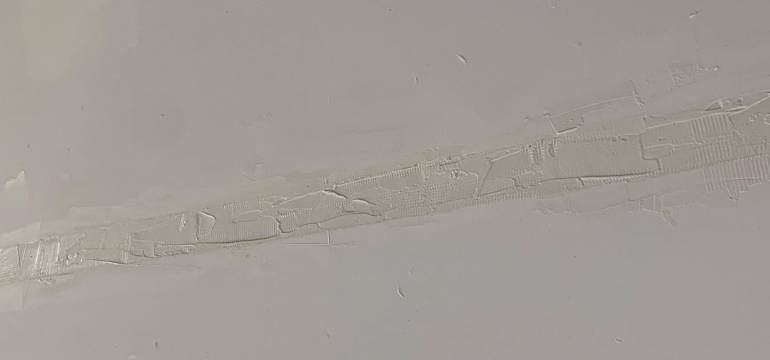How To Repair Drywall Cracks In Corners
The longer you live in your dwelling house, the more you'll realize that goose egg stays permanent, and fixes are rarely forever. Houses, like everything else on the planet, are constantly in a state of gradual decay, and they crave continual maintenance to keep them in good repair. One of the most abrasive instances of ongoing household wear and tear is drywall cracks.
In this guide, we'll talk nigh how to fix drywall cracks in general, and more specifically, how to fix a scissure in drywall that keeps coming back, even after you recall yous've repaired it adequately.
What Causes Drywall Cracks?

Many drywall cracks happen forth the seam between 2 panels of drywall. That seam, where the two sections meet, should accept been properly taped and mudded when the house was built, and the rooms were finished. Nevertheless, it's not always possible to be sure that the chore was correctly done in the first place.
Plus, years of use and various temperature changes, and foundation settling tin result in drywall cracks, even if the task was originally done right.
Let's take a closer look at some of the causes of recurring drywall cracks. Often, these cracks happen in areas of loftier stress and frequent apply. You lot may notice them around doors or windows or near beams or back up posts in the domicile. You may also notice cracks in the corners of rooms or virtually the ceiling.
As temperatures change, the drywall in your home contracts and expands just like other solids. Information technology'south non something y'all can necessarily prevent, although maintaining steady climate command for the interior is helpful. That normal process of expansion and contraction is stressful for drywall and can eventually cause tiny cracks along the seams.
Another common cause of drywall cracks is the settling of the building. Think about ancient cities from Roman times that have gradually sunk into the earth. That'south happening to your dwelling, too, although it's very gradual, peculiarly if the foundation has been properly constructed.
If the building is sitting atop fill up dirt, you may take a greater problem with settling. A croaky or faulty foundation can also be a serious issue that results in many stress cracks through the drywall.
Repairing Drywall Cracks That Keep Coming Back
Let's say that you lot've already tried to fix a couple of the drywall cracks in your home, but you lot've noticed that they keep returning. The drywall keeps dandy in the aforementioned spot for some reason. With a bit of careful analysis and some hard work, y'all should exist able to mend the cracks so that they won't announced again, or at least not for a while.
☆ What Not to Practice
When yous "stock-still" the drywall cleft last time, did yous simply spackle information technology, pigment information technology, and move on? If so, we can guarantee that'south why your drywall keeps cracking in the same spot. Y'all haven't given information technology plenty support and strength to stay in place; yous just temporarily covered the symptom of the problem.
☆ What You'll Need
To really become at the source of the issue, you're going to need some supplies. First of all, buy some fiberglass mesh drywall tape at a local hardware store or home improvement store. And then get yourself a container of patch compound or drywall mud, as well as some primer. Some products have both patch compound and primer together in 1 convenient formula.
You'll also need a 6-inch drywall knife, a putty knife, a pan or container to put the drywall mud in, a towel or tarp to cover your floor while you're working, and some of the paint you used on that item wall. Be sure the pigment matches exactly.
What To Exercise Beginning: Identify Drywall Record on the Crack

Starting time, use strips of drywall record to the crack. Usually, i side of the fiberglass drywall tape is already viscid. If not, use some of the drywall compounds like glue to help the tape attach to the wall.
Don't cover the crack with short strips in a row. Instead, follow the length of the crack with a long piece of record. If the scissure curves, take a second slice of tape and follow the bend. Attempt to place the tape so that the crack is straight in its centre.
The tape gives the drywall extra security, a stronger bond. It substantially pulls the 2 disjointed sections of drywall together and smooths over the cleft. Plus, it has a bit of requite and flexibility to allow for future shifting or fluctuations, so yous'll exist less likely to get a crack in that spot again.
The Adjacent Step: Add together Articulation Compound to the Crack

Once y'all've placed the drywall tape, spread some of the drywall mud or joint compound over the tape in a thin layer. Y'all want but enough to help the record attach. Let that dry for a bit, and so start spackling in earnest. Start at the center of the tape and spread the spackling compound or drywall mud outward and downward for the first layer.
Add a little more of the production, this time working upward. This downward motion, followed by the upward scraping, makes the tape stretch out a bit and helps it stick more than permanently without bubbles or ridges. Make sure that y'all continue to scrape the compound thin, or you'll have a large crash-land on the wall in the spot where you patched.
Wait half an hour for the chemical compound to dry, or wait for every bit long as the instructions on the container dictate. Then add another layer of compound, this time extending the layer of drywall mud out two inches to the correct and to the left of the tape. This new, broader layer of spackle compound is going to help y'all smooth out the entire area and ensure a make clean, polished look when you're finally done.
Using a 6-inch drywall pocketknife, smooth the entire section, feathering the edges and then that they slope smoothly and seamlessly into the existing paint and drywall. Feathering is accomplished by placing a tiny fleck more than pressure on the outer edge of the putty knife that'south connecting with the original drywall and paint. It gives a closer shave to the layer of compound and yields that feathered look.
After that, all that's left to do is allow the compound to dry out thoroughly, sand it a bit, and then pigment it to friction match your walls. If yous do this carefully, taking time on each step, few people volition be able to run across where the repair was fabricated.
Drywall Cracks That Proceed Coming Back Due to Serious Problems
Unfortunately, some drywall cracks aren't just at that place because of normal settling or seasonal temperature changes. Sometimes, a cleft in a drywall ceiling that keeps coming back could be due to a declining beam or a wet issue. Sometimes a cleft in a wall can bespeak serious foundation bug that require attention from a building inspector or an engineer.
⚠ Drywall Cracks Caused by Leaks
Cheque the drywall cracks in your abode by pressing the area effectually them lightly with your fingers. Is the drywall clammy or spongy to the touch? That would indicate a leak somewhere within the walls. Until you resolve the underlying effect of the leak, the problem will continue to worsen, and more than drywall cracks will appear, no matter how many times you record or patch them.
⚠ Drywall Cracks Acquired by Poor Drywall Installation
If you notice that the drywall near the cracks is bulging or buckling, the drywall in the entire room may have been hastily or poorly installed. Unfortunately, in that case, yous may need to dismantle the room's walls entirely and redo the drywall from the studs out. You tin replace it yourself with the help of DIY videos online, or y'all can hire a drywall contractor.
⚠ Drywall Cracks Caused by Foundation Problems and Structural Problems
Now we've come to the nigh unsafe of the drywall cracks—the ones that indicate a serious outcome with the abode's structure or foundation. These cracks are usually long, stretching along a large section of the wall or reaching across role of the ceiling. If a crack begins along the wall and continues onto the ceiling, that's a telltale mark of a structural problem.
If you lot've encountered cracks like these in your home, covering them up is probably not the best strategy. Y'all'll need to bring in a professional person, an expert in home construction and drywall problems, who tin can tell you lot whether or not your home needs all-encompassing (and expensive) structural piece of work or foundational correction.
Remember, y'all don't have to accept 1 single contractor's word for it. In fact, we suggest having two or 3 different contractors come and have a wait, and so you tin can become multiple opinions on the issue.
Having a few different estimates from the experts will provide some protection against fraud or contractors who might accept advantage of your state of affairs. In improver, exist certain to check online reviews and ratings for any company or private contractor you might hire to do repairs.
While this possibility might seem scary and expensive, keep in mind that most drywall cracks are perfectly normal and easy to fix yourself. The key to fixing a recurring scissure in drywall is non just a elementary spackle and paint job, but to go one step farther and tape along the fissure with some sturdy fiberglass drywall tape. With the tape in place and a perfect spackle and paint chore over the top, you'll exist able to enjoy a nice, smooth, crack-costless wall for a good long while.
- Author
- Recent Posts
![]()
Source: https://www.h2ouse.org/how-to-fix-a-crack-in-drywall-that-keeps-coming-back/

0 Response to "How To Repair Drywall Cracks In Corners"
Post a Comment